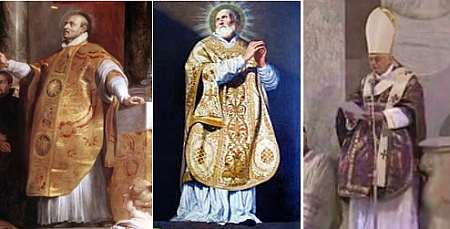De siste 12 år har kardinal Josef Tomko, titulær erkebiskop for basilikaen Santa Sabina, sagt til paven: «Vend om og tro på evangeliet. Husk at du er støv, og at du skal vende tilbake til støv.» Først sa han det til pave Johannes Paul II, nå til pave Benedikt XVI.

Mange la også merke til messehakelen paven brukte i dag; svært tradisjonell, mellom en gotisk og en romersk stil; lignende messehakler St. Ignatius av Loyola og St. Philip Neri brukte – se bildet over. (Se flere bilder her.)
“I must confess,” says the Cardinal in an interview with Osservatore Romano, “the personal unease that I experience every year doing so. Unease because of the words that go with the imposition of the ashes. I really find it difficult to say to the Pope ‘Repent and believe in the Gospel’, when it is he who has the full right to say it to me and to everybody else.”
– But does the Ritual of the Ashes still have a significance for contemporary man?
The imposition of ashes is not a theatrical gesture nor a formality. It is a sacramental rite which helps us to salvation. From the wealth of texts and gestures, we choose the words from Scripture to accompany the rite of the Ash Wednesday liturgy, and those are the two sentences with which the priest makes the imposition of ashes even more significant.
The ashes, dust, are a very eloquent sign of fragility, of man’s sin and mortality. Receiving it on our head, we recognize that our bodies will return to dust, that we are fragile creatures, limited. That wealth, knowledge, science, glory, power, titles, dignities mean nothing ultimately. Unfortunately, pride, selfishness, the temptation to decide for ourselves what is good or bad, the exaltation of our own desire for freedom above the will of the Creator, are always present in the heart of man.
– What commitments should a Christian have during the period of Lent?
Jesus asks us particularly at this time of the liturgical year three things: almsgiving, prayer, fasting.
Almsgiving as the expression of a more attentive generosity and that charity which ‘covers the multitude of sins’; prayer which comes from the heart, not from the lips; fasting, which can be a sacrifice for the body, but takes other modern forms of renouncing unnecessary or even ultimately harmful things we are used to, such as fasting from TV, or some usual pleasures, or even from dangerous or risky friendships.
-Every Ash Wednesday, starting in 1996, you have placed the ashes on the head of the Pope at Santa Sabina. What have been your experiences?
I would start from when I was still a seminarian and took part with my classmates at the station church of Pius XII. I can remember what the fervor was in those days. This is a tradition that is very much felt in Rome, and those memories have remained in my heart, and were only reinforced when I was assigned Santa Sabina as my titular church.
But of this experience, I must say that I find it truly difficult to say to the Pope, “Repent and believe the Gospel!’ when it is him who has the full right to tell me this and everyone else! How could I admonish the Pope himself?
Even the other formulation, the “Memento homo…’, is difficult to say. It became even more so as John Paul II grew older – it was like reminding him what he not only knew but felt in his own physical being. Sometimes I used one, sometimes the other formula. It is a very personal choice, but very significant. The choice is not mine nor the Pope’s – these are words of God before which all of us must bow our heads.
– After the explicit invitation of Benedict XVI in Spe salvi, can Christians find in Lent the opportunity to rediscover and enlarge their horizons for hope?
Lent is the commemoration of the Passion and Death of our Lord, and we live it as part of the Paschal mystery – which ends and reaches its peak in the resurrection.
Just as Lent opens us to the Resurrection, so too should human hope, which is not limited to this life, nor by our human limitations, but is based on eternal life which Jesus has assured for us through his death and resurrection. So, Lent necessarily leads our thoughts to Easter – the Easter of Jesus, but also our own Easter when our time comes.
